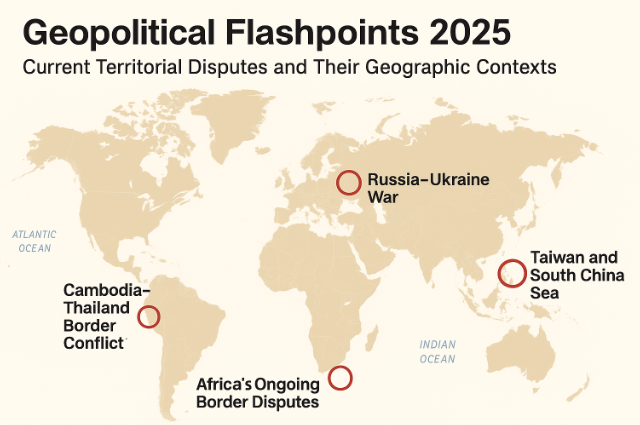
In 2025, the world is gripped by a new wave of geopolitical stress, as old wounds over borders and sovereignty resurface alongside new confrontations. Territorial disputes remain a defining feature of the international landscape, shaped by regional rivalries, historical legacies, and contemporary ambitions. These flashpoints not only determine the fate of nations and communities but also influence the balance of global power.
Cambodia–Thailand Border Conflict
One of the most serious flare-ups this year has been the renewed conflict between Cambodia and Thailand. On July 24, 2025, violence erupted into the deadliest clash between the two nations in more than a decade, leaving many casualties and displacing hundreds of thousands. The roots of this dispute trace back to ambiguous colonial-era boundaries, where outdated maps still hold the power to ignite modern wars.
The contested region is a patchwork of forests and farmland dotted with villages, where loyalties are blurred by ethnic and cultural ties. Geography here is both physical and psychological. A fragile ceasefire—brokered with pressure from stakeholders such as ASEAN, Malaysia, the United States, and China—underscores the border’s complexity. It is not only a strip of land but also a corridor for trade, migration, and great-power rivalry.
Africa’s Colonial Legacy of Borders
Africa continues to simmer with disputes rooted in colonial divisions. Borders drawn by foreign rulers often ignored ethnic, linguistic, and ecological realities, creating a patchwork of tensions. In early 2025, a renewed clash between Ethiopia and Eritrea recalled the devastating war of 1998–2000.
Meanwhile, conflicts in Sudan and the Democratic Republic of Congo have displaced millions. Geography here is inseparable from struggle: rivers, plateaus, and mineral-rich lands are battlefields of identity, survival, and state power. The disputes intensify internal migration, exacerbate climate change, and fuel competition over fertile lands and natural resources.
Russia–Ukraine Conflict
In Europe, the war between Russia and Ukraine remains unresolved. Diplomatic pressure for a ceasefire is mounting, but no permanent solution is in sight. Disputes over Crimea and the Donbas are tied deeply to geography: the Black Sea coast, strategic river valleys, and industrial hubs are both prizes and obstacles.
For Ukraine, the struggle is about sovereignty and national identity. For Russia, it is about creating a buffer zone and asserting historical claims. The conflict is intensified by cultural and linguistic divisions within disputed territories, as well as the involvement of Western powers and Russia’s allies.
Taiwan and the South China Sea
In Asia, Taiwan and the South China Sea remain epicenters of tension. Taiwan, located off China’s southeastern coast, is a vital hub along some of the busiest sea routes in the world. Beijing views it as a core interest, while the U.S. reinforces Taiwan’s “porcupine defense” strategy. Taiwan’s geography makes it both a shield and a launch point in regional power dynamics.
The South China Sea highlights the geopolitical power of geography even more starkly. Spanning from Vietnam’s coast to the Philippines and Malaysia, the sea contains hundreds of islands, reefs, and atolls. Rich in oil, gas, and fisheries, it is also a vital shipping route. China’s sweeping “Nine-Dash Line” claim collides with those of other coastal nations, while its artificial islands and military bases symbolize the chessboard of great-power rivalry.
The Indian Subcontinent
On the Indian subcontinent, disputes remain as enduring as the Himalayas themselves. Since 1947, the Kashmir region—mountains, glaciers, and densely populated plains—has remained contested between India, Pakistan, and China.
Other disputes, such as those over the Indus Delta’s 96 km tidal channel and even lesser-known claims like Junagadh and Manavadar, show that no territory is too small to carry layers of historical memory and political tension.
Conclusion: Geography at the Heart of Conflict
Geography lies at the core of every flashpoint. Natural barriers divide peoples, corridors connect and divide economies, and resources fuel competition. These conflicts are rarely just about maps—they are about power, identity, and survival. Both superpowers and regional actors attempt to bend geography to serve their strategic ambitions, making 2025 a year where borders once again define the global order.
